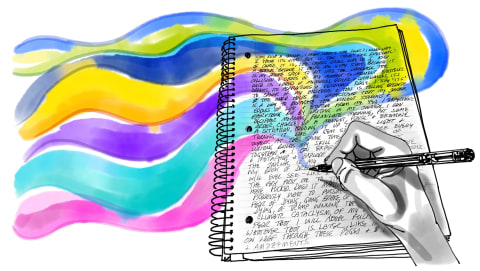
In the realm of songwriting, the art of crafting melodies holds an indispensable role. A harmonious blend of various elements can elevate a song to new heights, resonating with its audience on a profound level.
This article delves into the top 10 essential elements in songwriting, exploring everything from lyrics and chord progressions to emotional impact and originality.
Through an objective and analytical lens, we aim to provide knowledge and insights to empower aspiring songwriters in their creative pursuits.
Melody
The melody is an integral component of any song, serving as the primary musical motif that captures the listener's attention and evokes emotions. It is the melodic line that carries the lyrics and hooks the audience, making it crucial for songwriters to master the art of melody development and melodic variation.
Melody development refers to the process of creating a memorable and compelling melodic line that progresses and evolves throughout the song. This involves crafting a strong melodic hook, exploring different melodic ideas, and incorporating variations to keep the listener engaged.
Melodic variation, on the other hand, involves altering and embellishing the melody to add interest and depth. This can be achieved through techniques such as ornamentation, rhythmic variations, and melodic contour changes.
Lyrics
While often overshadowed by the melody, lyrics play a crucial role in songwriting, conveying the message, emotions, and storytelling that connect with the listeners on a deeper level.

Song interpretation is a subjective experience, where listeners find personal meaning and connection in the lyrics. Lyrical storytelling is an art form that allows songwriters to paint vivid pictures, evoke emotions, and create narratives that resonate with the audience.
Through carefully chosen words and phrases, songwriters can capture the essence of a story or emotion, creating a powerful and relatable experience for the listener. The interpretation of lyrics can vary from person to person, allowing for individual freedom and expression.
Whether it's a heartbreak ballad or an anthem of empowerment, lyrics have the power to touch the soul and leave a lasting impression.
Chord Progressions
Several chord progressions and their distinctive patterns have become iconic in the world of music, as they provide the foundation for creating melodies and harmonies that captivate listeners. Harmonic exploration is key in developing chord progressions that evoke emotion and captivate the audience. Musicians often experiment with different chord progressions, seeking to create unique and captivating combinations.
Creative chord voicings play a crucial role in adding depth and complexity to a song. By using alternative chord voicings, musicians can create unexpected and interesting harmonic textures. This allows for greater freedom and expression in songwriting, as it opens up new possibilities for creating melodies and harmonies that are fresh and exciting.
Ultimately, chord progressions are an essential element in songwriting, providing the framework for creating memorable and captivating music.
Song Structure
One of the essential elements in songwriting is the songwriter's ability to understand and effectively utilize the possessive noun of song structure, in conjunction with the coordinating conjunction, to create a cohesive and engaging musical composition. Song structure refers to the organization and arrangement of different sections within a song, providing a framework for the overall flow and progression.

Here are three key components of song structure:
Verse: The verse is the main storytelling section of the song, where the lyrics and melody unfold. It sets the stage for the rest of the song and often repeats throughout.
Bridge: The bridge acts as a contrasting section that breaks up the repetition of the verse and chorus. It adds variety and can provide a moment of emotional release or tension.
Pre-chorus: The pre-chorus serves as a buildup section, leading into the chorus. It often contains a catchy melody or hook that builds anticipation for the chorus.
Rhythm and Groove
Exploring the rhythmic patterns and infectious grooves is a crucial aspect of creating captivating and memorable songs. The groove, which refers to the rhythmic feel and flow of a song, is what makes people want to move and dance to the music.
The tempo, or the speed at which the music is played, also plays a significant role in establishing the groove. Artists often experiment with different rhythmic variations to add complexity and interest to their songs. These variations can include syncopation, polyrhythms, and unexpected accents.
Hooks and Catchy Phrases
Hooks and catchy phrases play a crucial role in the success of a song. They are the elements that grab the listener's attention and remain in their memory long after the song is over.

A memorable chorus melody can make a song instantly recognizable and create a strong emotional connection with the audience. It is the part of the song that people eagerly wait for and eagerly sing along to. Crafting a catchy chorus melody requires skillful composition and an understanding of what resonates with listeners.
Crafting catchy lyrical hooks involves creating clever and memorable phrases that stick in the listener's mind. These hooks make the listener want to sing along and become a part of the song. Writing catchy hooks requires a deep understanding of what resonates with listeners and the ability to create phrases that are both clever and memorable.
Memorable Chorus Melodies
Crafting unforgettable chorus melodies is a vital aspect of songwriting, as they allow the listener to connect emotionally and instantly recognize the song. To create memorable chorus melodies, songwriters often employ certain techniques that enhance the impact of the chorus. Here are three essential elements to consider:
Creating Contrast: A chorus melody should stand out from the verses and pre-chorus sections to make it more memorable. This can be achieved by using different melodic patterns, higher or lower pitch ranges, or rhythmic variations.
Vocal Delivery: The way the chorus melody is sung plays a crucial role in its memorability. A powerful vocal performance, with emphasis on key words and phrases, can make the chorus more captivating and engaging for the listener.
Hooks and Catchy Phrases: Incorporating hooks and catchy phrases in the chorus melody can make it instantly recognizable and memorable. These can be simple yet effective melodies or lyrics that stick in the listener's mind long after the song is over.
Crafting Catchy Lyrical Hooks
Through careful consideration and strategic placement, songwriters can weave together double prepositions and coordinating conjunctions to create captivating and memorable lyrical hooks.

Crafting memorable melodies is a crucial aspect of songwriting, but the power of catchy lyrical hooks should not be underestimated. These hooks serve as the focal point of a song, drawing in listeners and leaving a lasting impression.
To create a hook that resonates with the audience, songwriters must explore different vocal styles and find the perfect combination of words and melody. Whether it's a catchy phrase or a clever play on words, the key is to make the hook memorable and easy to sing along to.
Emotional Impact
When it comes to crafting a song that leaves a lasting emotional impact on listeners, several elements come into play.
First, the lyrics and mood of the song play a crucial role in evoking specific emotions and connecting with the audience on a deeper level.
Additionally, the use of melodic hooks can enhance the emotional impact by creating memorable and catchy melodies that resonate with the listener.
Lastly, the choice of instrumentation and dynamics can further intensify the emotional journey of the song, allowing for moments of vulnerability, intensity, and release.
Lyrics and Mood
The emotional impact of lyrics plays a crucial role in the overall mood of a song. Lyrics have the power to transport listeners to different emotional landscapes, evoking a wide range of feelings and connecting them to the essence of the song.

Here are three key elements that contribute to the emotional impact of lyrics:
Emotional Storytelling: Lyrics that tell a poignant and relatable story have the ability to deeply resonate with listeners. Through vivid imagery and powerful storytelling, songwriters can create an emotional journey that captivates and moves the audience.
Lyrical Vulnerability: When songwriters express vulnerability in their lyrics, it allows listeners to connect on a deeper level. By sharing personal experiences, thoughts, and emotions, songwriters create a sense of authenticity that can touch the hearts of listeners.
Word Choice and Phrasing: The choice of words and the way they are delivered can greatly influence the emotional impact of lyrics. The use of metaphors, similes, and poetic devices can enhance the lyrical experience, creating a more profound emotional connection with the audience.
Melodic Hooks
How can melodic hooks create a powerful emotional impact in songwriting?
Melodic hooks have the ability to captivate listeners and elicit strong emotional responses. By using melodic phrasing and variation, songwriters can create memorable and catchy melodies that grab the attention of the audience.
A melodic hook is a repetitive and easily recognizable musical phrase that becomes the centerpiece of a song. It serves as the musical glue that holds the entire composition together. The repetition of a melodic hook helps to reinforce the emotional impact of the song, making it more memorable and relatable to the listener.

Additionally, adding melodic variation to the hook can create tension and release, further enhancing the emotional impact of the song. The combination of melodic phrasing and variation in a melodic hook is a powerful tool that allows songwriters to connect with their audience on a deep emotional level.
Instrumentation and Dynamics
By carefully selecting the instrumentation and manipulating dynamics, songwriters can create a powerful emotional impact in their compositions. The choice of instruments and how they are played can greatly influence the emotions conveyed in a song.
Here are three essential instrumentation techniques and dynamic contrast to consider:
Instrumentation Techniques: Experimenting with different combinations of instruments can add depth and texture to a song. For example, using a delicate piano melody accompanied by a soaring string section can evoke a sense of nostalgia or melancholy.
Dynamic Contrast: Varying the volume and intensity throughout a song can create tension and release, capturing the listener's attention. Transitioning from a soft, intimate verse to a loud, explosive chorus can amplify the emotional impact.
Instrumental Solos: Incorporating instrumental solos can provide moments of intensity and showcase the talent of individual musicians. These solos can evoke emotions that words alone may struggle to convey.
Arrangement and Instrumentation
With careful consideration of arrangement and instrumentation, songwriters can elevate their compositions to new heights. The choice of instruments and the way they are arranged within a song can greatly impact its overall sound and effectiveness.

Instrumentation choices play a crucial role in shaping the mood and tone of a song, as different instruments have unique timbres and characteristics. Songwriters can experiment with a variety of instruments, such as guitars, keyboards, drums, or even unconventional choices like the theremin or sitar, to bring their musical ideas to life.
Additionally, arranging techniques, such as layering different instruments, creating dynamic contrasts, or utilizing orchestration, can add depth and complexity to a song.
Dynamics and Contrast
Dynamics and contrast play a crucial role in creating engaging and memorable songs.
One important aspect is the use of musical tension and release, where the dynamics are manipulated to create an emotional impact on the listener.
This can be achieved through dynamic shifts, where the intensity of the music changes to provide contrast and keep the listener engaged.
Musical Tension and Release
The careful manipulation of musical tension and release is crucial for creating a captivating and dynamic composition. By strategically using tension and resolution, songwriters can engage listeners and take them on a musical journey.
Here are three key ways in which tension and release contribute to the art of musical storytelling:

Building anticipation: The use of tension in a song creates a sense of anticipation and excitement, keeping the listener engaged and eager for resolution.
Emotional impact: Tension and release can evoke a range of emotions in the listener, from suspense and anxiety to relief and satisfaction, adding depth and complexity to the musical experience.
Creating contrast: The contrast between moments of tension and release provides variation and keeps the song from becoming monotonous, allowing for a more dynamic and interesting composition.
Dynamic Shifts for Impact
During the course of a song, incorporating dynamic shifts and contrast at strategic moments can greatly enhance its impact on the listener.
Dynamic shifts refer to changes in volume, intensity, and energy levels within a song, while contrast involves juxtaposing different elements to create interest and tension.
These techniques are crucial for creating a sense of progression and keeping the listener engaged throughout the song.
By varying the dynamics, from soft to loud or vice versa, songwriters can build tension and create moments of impact. These shifts can be used to highlight certain lyrics or melodies, adding depth and emotional resonance to the music.

Furthermore, contrast can be achieved by introducing unexpected elements such as changes in instrumentation, rhythm, or harmonic progression. This adds excitement and surprise, further enhancing the overall impact of the song.
Originality and Innovation
In the realm of songwriting, creativity stands as an essential trait for artists to cultivate in order to achieve originality and innovation in their music. The ability to push boundaries and create something unique is what sets apart great songwriters from the rest.
Here are three elements that contribute to originality and innovation in songwriting:
Fresh and unexpected melodies: Creating melodies that are catchy yet unexpected can make a song stand out. Experimenting with unusual intervals and unexpected twists can add a touch of originality to a composition.
Unique lyrical perspective: Expressing personal experiences and emotions in a unique and unconventional way can bring a fresh perspective to songwriting. Using unconventional metaphors and wordplay can add depth and intrigue to the lyrics.
Experimental arrangements and production techniques: Incorporating unconventional instruments or experimenting with production techniques can lead to innovative soundscapes. Breaking away from traditional song structures and embracing experimentation can result in a more unique and engaging musical experience.
Frequently Asked Questions
How Can I Improve My Songwriting Skills and Create More Memorable Melodies?
To improve songwriting skills and create more memorable melodies, focus on enhancing creativity and storytelling abilities. Experiment with different chord progressions, melodies, and lyrics to find unique and captivating combinations that resonate with your audience.

What Are Some Common Mistakes to Avoid When Writing Lyrics?
When writing lyrics, it is important to avoid common mistakes that can hinder the impact of the song. To craft impactful lyrics, consider tips such as avoiding clichés, maintaining coherence, and ensuring emotional resonance with the audience.
How Do Chord Progressions Contribute to the Overall Feel and Emotion of a Song?
Chord progressions play a crucial role in shaping the overall feel and emotion of a song. The importance of modulation in chord progressions lies in its ability to create tension and release, adding depth and complexity. Exploring unconventional chord progressions can provide a unique emotional impact, allowing for artistic freedom and expression.
What Are Some Popular Song Structures That I Can Use as a Starting Point for My Own Compositions?
Different song structures serve as starting points for song compositions, providing a framework for organizing musical ideas. Popular structures include verse-chorus, AABA, and ABAB. These songwriting techniques offer flexibility and allow for creative expression within a structured framework.
How Can I Add More Depth and Complexity to the Rhythm and Groove of My Songs?
To add depth and complexity to the rhythm and groove of songs, explore polyrhythms and syncopation in songwriting. Additionally, incorporate unconventional instruments and sounds to enhance the overall rhythm and groove of the composition.
 Writing TipsCreative WritingJournalingSketching TechniquesBuying GuidesPrivacy PolicyTerms And Conditions
Writing TipsCreative WritingJournalingSketching TechniquesBuying GuidesPrivacy PolicyTerms And Conditions
